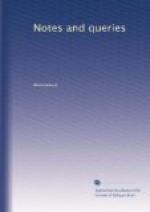“D.O.M. Jussu Georgii IV. Magnae Britanniae &c., Regis, et curante Equite exc. Carolo Stuart Regis Britanniae Legato, caeteris antea rite peractis et quo decet honore in stirpem Regiam hic nuper effossae reconditae sunt Reliquiae Jacobi II., qui in secundo civitatis gradu clarus triumphis in primo infelicior, post varios fortunae casus in spem melioris vitae et beatae resurrectionis hic quievit in Domino, anno MDCCI, v. idus Septemb., MDCCCXXIV.”
At the foot of the monument were the words—
“Depouilles mortelles de Jacques 2. Roi d’Angleterre.”
A third monumental inscription to the memory of James II., in Latin, is to be seen in the chapel of the Scotch College in Paris. This memorial was erected in 1703, by James, Duke of Perth. An urn, containing the brains of the king, formerly stood on the top of it. A copy of this inscription is preserved in the Collectanea Topographica et Genealogica, vol. vii.
J. REYNELL WREFORD, D.D.
Bristol, November 8. 1850.
* * * * *
JUDGE CRADOCK.
My transplantation from Gloucester to Devonshire, and the consequent unapproachable state of my books, prevents my referring to authorities at the moment in support of what I have said about the arms of Judge Cradock alias Newton: still I wish to notice the subject at once that I may not appear to shrink from the Query of S.A.Y. (Vol. ii., p. 371.)
I happen to have at hand a copy of the Grant {428} of Arms to Sir John of East Harptree, Somerset, in 1567 in which, on the authority of the heralds of the day, arg. on a chevron az. 3 garbs or, are granted to him in the first quarter as the arms of Robert Cradock alias Newton. The Judge seems to have been the first of the family who dropped the name of Cradock. His forefathers, for several generations (from Howel ap Grononye, who was Lord of Newton, in Rouse or Trenewith, in Poursland), went by the name of Cradog Dom. de Newton.
Robert Cradock, mentioned in the Grant I have quoted, married Margaret Sherborne. He was the Judge’s great-great-grandfather. Sir John Newton, to whom the grant was made, lies buried at East Harptree; and on his tomb may be seen (besides his effigies as large as life) the twelve quarterings in their original (?) blazoning, impaled with those of his wife, one of the Pointz family. The same arms (of Newton) are still discernible on a beautifully wrought, though now much mutilated shield, over one of the doors of Barres Court, at East Hanham, in Bitton, Gloucestershire, where Newton also had a residence, where John Leland on his itinerary visited him, and says (Itin. vol. vii. p. 87.) “his very propre name is Caradoc,” &c. This property Newton inherited as a descendant from the De Bittons or Button (through Hampton), a family of great note in their day, and residents on the site of Barres Court, a “fayr manner place




